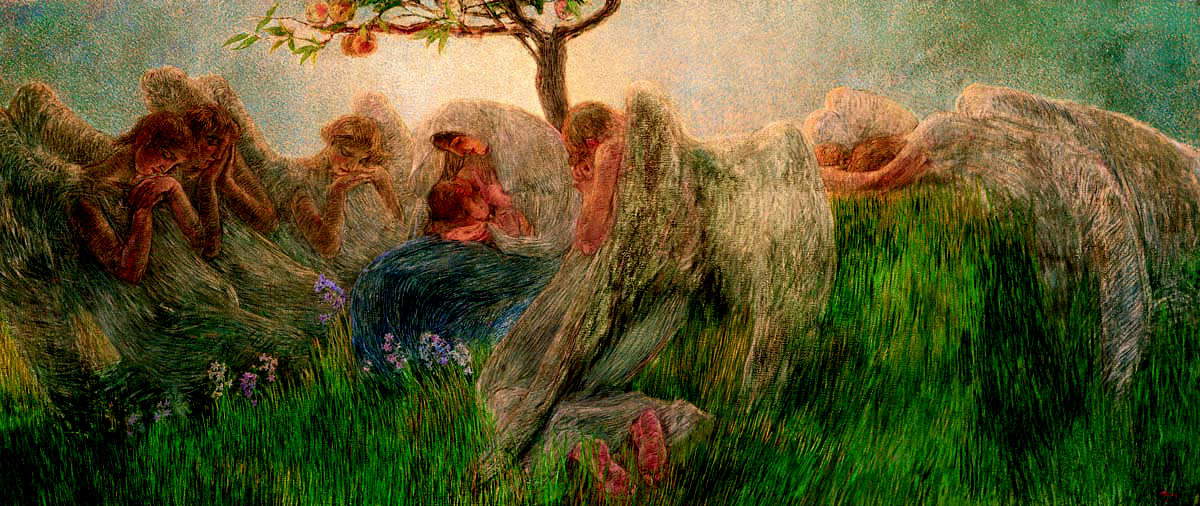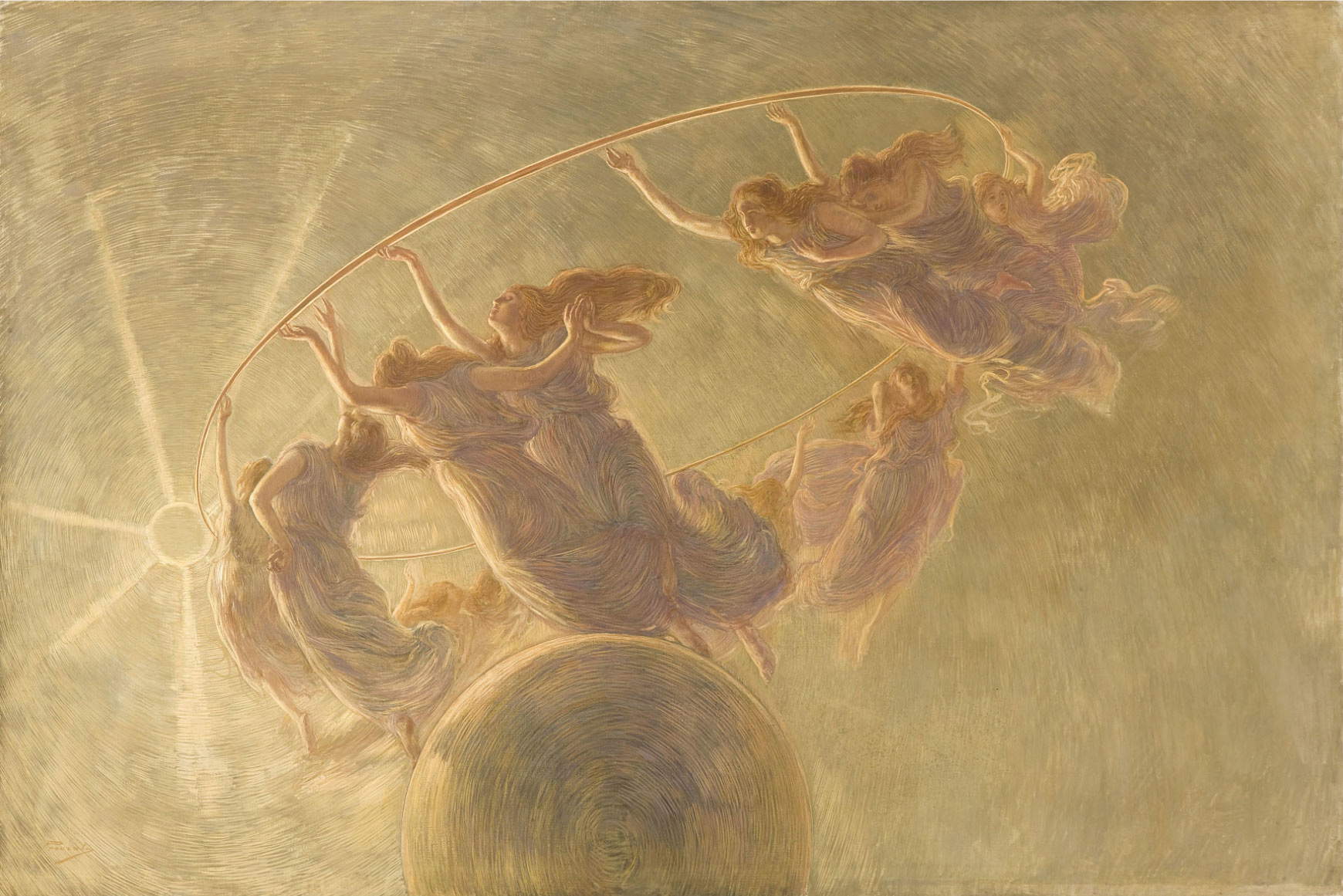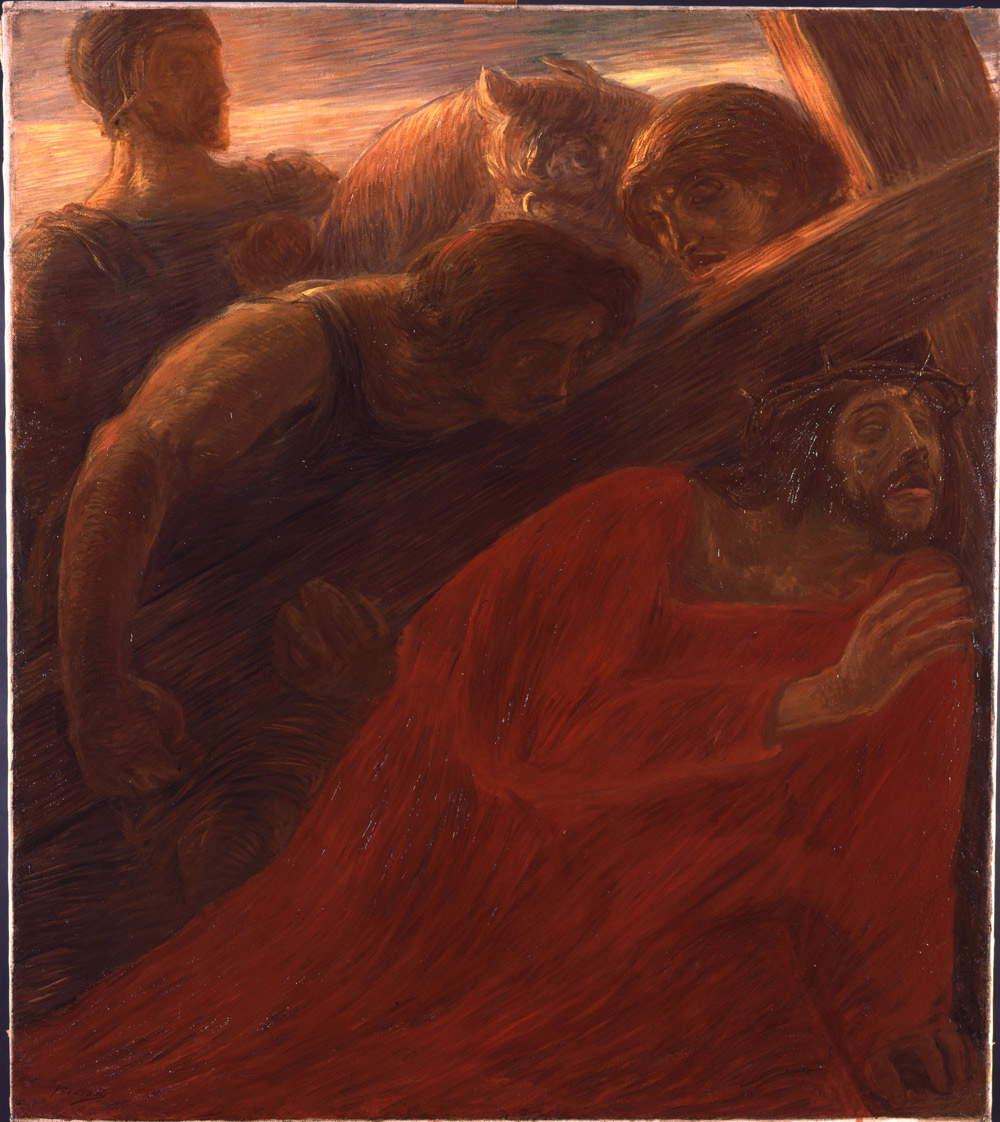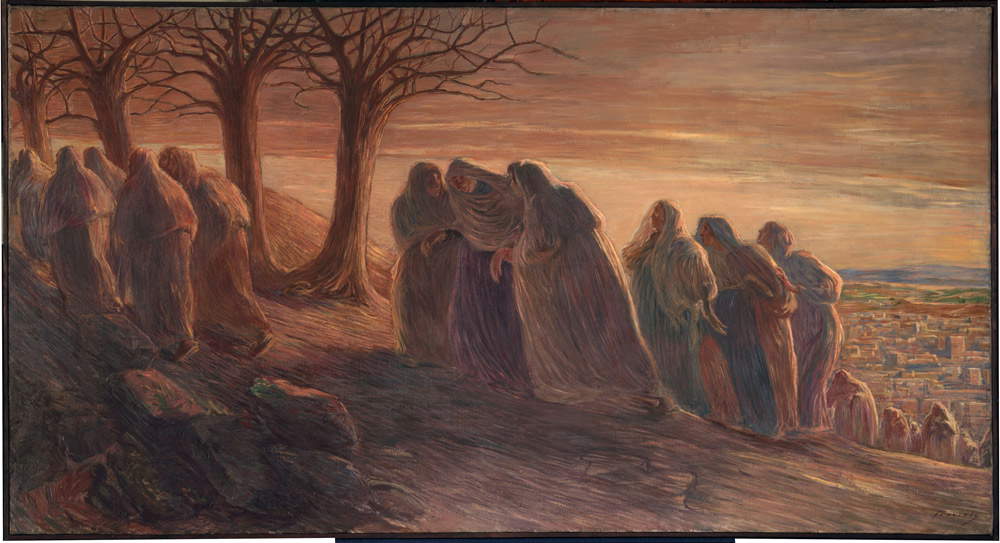Gaetano Previati (Ferrara, 1852 - Lavagna, 1920) was an Italian painter, a well-known exponent of the Divisionist movement. His training took place mainly in Milan, where he studied at the Brera Academy, an environment in which he absorbed all the influences from the masters of Romanticism and Realism. Previati’s was a unique style, characterized by an innovative use of light and color. After a youthful moment in which he approached the experience of Scapigliatura, he adopted a style that was a fundamental contribution to the formation and development of divisionism: by separating pigments into lines, filaments and dots, he succeeded in creating vibrant luminous effects. In particular, Previati is remembered for Maternity, a work that raised important discussions in late 19th-century Milan.
In addition to painting, Previati wrote theoretical texts that delved into the principles and codes of Divisionism and Symbolism, contributing significantly to the artistic debate of his time. His work influenced many contemporary and later artists, leaving a lasting mark on Italian and European art. From Gaetano Previati’s experience, as well as that of Giuseppe Pellizza da Volpedo, the Futurist movement took shape and substance a few years later, in 1909.

Gaetano Previati was born in Ferrara on August 31, 1852, the son of watchmaker Flaminio Previati and Riccarda Benvenuti Bonlei, who died in childbirth two years later. His father later married on his second marriage to Cornelia Facchini. In 1870 the young Previati dropped out of his studies at the local technical institute in order to attend painting classes taught by Girolamo Domenichini and Giovanni Pagliarini. In the same year, he participated in the National Exhibition of Fine Arts in Parma. In the following years he was in Florence, where he occasionally attended the studio of Amos Cassioli, and finally his strong interest in the arts led him to theBrera Academy in Milan, where he took courses under master Giuseppe Bertini for three years.
In 1879, Previati won the Canonica Foundation Prize with Gli ostaggi di Crema. With this first work, it is evident how much the artist had not acceded to the manners and manners of his teachers. Previati manifested a spirit of independence that critics described as “a bold artistic temperament to the point of exaggeration.” To this period correspond such compositions as Abelard and Heloise, Torquato Tasso, works with historical subjects and responding to a certain theatricality, rendered with great objectivism. In the decade from 1880 to 1890, Previati was marked by rather discouraging events: stringent economic difficulties, a long illness; in 1883 he sent two paintings to the National Exhibition in Rome, which returned a failure. The artist gathered in a period of spiritual crisis that led him to briefly approach the circles of the Milanese Scapigliatura. In this experience made up of weaknesses, Previati returned to the themes of Romantic medievalism(Il bacio, 1889-1891) until the maturation of a lucid sense of Christian tragedy: in this regard, the versions of the Three Marys at the Foot of the Cross and the fourteen canvases of the Via Crucis are worth mentioning.
The work Maternity, exhibited in Milan at the 1891 Triennale, was the painting that more than any other unleashed a critical storm, because of the singularity of the Divisionist technique adopted. Gaetano Previati was a key figure in the definition of this technique, of which he was a careful examiner and theoretician. The artist had approached pointillism with the intention of reconciling the existing contrast between the metaphysical nature of the image and the physical nature of the pictorial material: from an analytical study of color he devoted himself to the drafting of golden and silvery ranges, taking care to juxtapose them in threadlike and sinuous brushstrokes.
In the years from 1895 to 1914, Previati was invited to exhibit in international art shows in Venice; in particular, he held two solo exhibitions in 1901 and 1912. In 1907 he participated in the 7th Venice Biennale, contributing to the installation of the Sala del Sogno and then exhibited some works at the Salon des peintres divisionnistes italiens organized in Paris by the merchant Alberto Grubicy; the latter’latter, together with his brother Vittore, founded the Society for the Art of Gaetano Previati in 1911, acquiring a substantial nucleus of his paintings that were presented in exhibitions organized in Genoa in 1915 and the following year and in 1919 in Milan.
The artist died at the age of 67 in 1920 in Lavagna, a Ligurian town not far from Chiavari, where he spent long stays in his last years. He was buried in the monumental cemetery of the Certosa di Ferrara. Gaetano Previati’s reasonings and theories on Divisionist technique are collected in two volumes, La tecnica della pittura (Turin, 1905) and I principi scientifici del divisionismo (Turin, 1906).




The youthful work The Hostages of Crema launched Previati into the cultural scene of his time. The painting depicts some prisoners during the expulsion of an enemy city. With this early work Previati gained recognition that validated his distancing himself from the teachings of his masters. An outcome of the most critical moment of the 1880-1890 decade is the Kiss, datable to 1889-1891 (private collection), which corresponds to the artist’s reinterpretation within the framework of Romantic medievalism. There is already a hint of juxtaposed brushstrokes, though still far from the thinning of brushstrokes into long strands of color.
Unlike many other Lombard painters of his time, Previati came to pointillism out of a need to convey an idea through the physical study of matter, and not from a view from life. The lyricism and vibrations proper to the medium of painting had to be functional to the feelings he intended to communicate in his works. For this he made use of divided and forthright hues, arranged by strands of colors juxtaposed in a sinuous sense, according to a rhythm intended to render a fluctuating aspect of the inner concept.
With Maternity, Previati left a mark to which critics responded by judging the work negatively and declining its suitability for exhibition. The scene depicts a mother, a re-imagining of the Madonna, breastfeeding her child. Behind them is a light-filled tree that recalls the tree of life. The painting approaches, but not explicitly, a religious dimension. The release of this painting was accompanied by a critical text by the painter Vittore Grubicy de Dragon, who testified to its essence in the face of the most vocal criticism of the painting: in fact, because of the ways in which it was made, very few people liked the painting, traversed by a myriad of large brushstrokes that made the whole space vibrate.
“[...] to forms and colors Previati did not attach any objective importance, but availed himself of them only as signs and within the limit strictly necessary to express the overall idea; it is therefore that he resorted to that synthetic, arbitrary simplification and even alteration of forms and colors which, in a variety of terms, were stigmatized by all” (Vittore Grubicy de Dragon in Cronaca dell’Esposizione di Belle Arti, 1891). What Previati did in this painting was essentially to focus on theidea of motherhood: he wanted to render and represent in the strongest and most powerful way possible the idea of a mother.
Previati’s symbolism stood out here in the panorama of the 1891 exhibition; a few meters away from this painting was another image on the theme of motherhood, namely The Two Mothers by the Divisionist artist Giovanni Segantini (1858 - 1899), which was more realistic and was made especially for the Brera Triennale.
In The Dance of the Hours, a title that also recalls a musical ancestry, Previati refined the Divisionist technique in a subject of profane scope. Dated 1899, Previati defined his idea of light in a rendering made up of luminous vibrations. To this idea we can also juxtapose the different versions of Ilcarro del sole (from around 1900) and also the canvas with Paolo e Francesca, executed for the 8th Venice Biennale, dated 1909. The latter is a painting to be framed in the Symbolist context, already made with a matured and achieved awareness of Divisionist expression. Previati then immersed himself in the religious dimension with the fourteen reddish paintings of the Via Crucis, preserved in the Collection of Contemporary Art of the Vatican Museums. In these canvases, the artist renders a new composition, a powerful invention made up of synthetic drawings and fiery colors that swell its tragic impetus.
In the Funerali di una vergine (Funerals of a Virgin), Previati now found himself totally involved in the most sacred dimension of art: dated 1912-13, after two versions, in the third canvas he restores the silent farewell to a white creature, the light and sorrowful atmosphere of a farewell in the form of a triptych, where the figures bring to mind the mosaics with the theories of virgins in the basilica of Sant’Apollinare Nuovo in Ravenna.





In Ferrara, the painter’s native city, the painting with Paolo and Francesca and the canvas with theAssumption can be seen at the Museo dell’Ottocento. In Lombardy, at the Museo di Crema e del Cremasco is the 1879 painting, Gli ostaggi di Crema. In Novara, the manifesto work of Divisionism, Maternity (1890-1891) is kept in the Collections of the Banca Popolare di Novara. Instead, in Milan, in the Art Collections of the Fondazione Cariplo, is La danza delle ore, while in the Pinacoteca di Brera is preserved Funerali di una vergine in its 1895 version.
The version considered in this text, dating from 1912-1913, is kept instead in the National Gallery of Modern and Contemporary Art in Rome. Also in the capital, as anticipated, the Vatican Museums’ Collection of Contemporary Art displays the paintings of the Way of the Cross. In Florence, in the Galleria d’Arte Moderna of Palazzo Pitti, there is an oil on canvas with the title of Nel prato (Peace), datable to 1889-1890. Abroad, in Brazil one can encounter a Landscape by Previati dated 1905, exhibited at the São Paulo Museum of Art.
 |
| Gaetano Previati. Life and works of the master of Divisionism |
Warning: the translation into English of the original Italian article was created using automatic tools. We undertake to review all articles, but we do not guarantee the total absence of inaccuracies in the translation due to the program. You can find the original by clicking on the ITA button. If you find any mistake,please contact us.